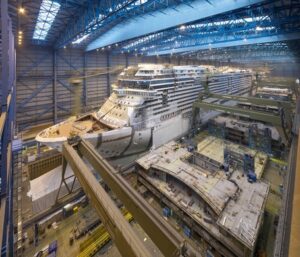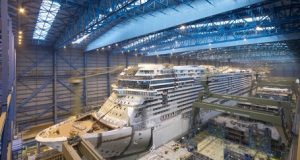www.lzh.de/en
Especially for shipbuilding and other maritime applications, the further development of thick metal sheet welding is interesting. The Laser Zentrum Hannover e.V. (LZH), together with Held Systems Deutschland GmbH, Laserline GmbH and Meyer Werft GmbH & Co. KG, now wants to establish robust, pure laser welding processes for steel sheet thicknesses of up to 30 millimeters. For this purpose, diode laser beam sources are to be brought to peak performance.
The processes for joining maritime steel components have a great development potential in terms of production costs and productivity: the frequently used submerged arc welding is comparatively slow and involves significant workpiece distortion. Laser-arc hybrid welding, as an alternative process, requires labor-intensive edge preparation and is not very flexible.
Particularly for large steel sheet thicknesses in the range of 12 millimeters to 30 millimeters, no method has been able to prevail against submerged arc welding. The scientists at the LZH now want to change this together with their partners Meyer Werft GmbH & Co. KG, Held Systems Deutschland GmbH and Laserline GmbH.
Robust, pure laser welding processes
The scientists want to develop robust, pure laser welding processes, especially for thick metal sheet welding in the maritime sector. For this purpose, the project partner Laserline will realize new diode laser beam sources with a maximum output power of up to 60 kilowatts in continuous-wave mode. The aim of the project is to achieve high-quality joints with high welding speeds. The partners want to reduce the costs for edge preparation and the amount of additional material compared to existing joining methods. In that way, the costs shall be reduced eventually. The new processes shall complement or even replace the existing ones.
The application-oriented development takes place in parallel in a laser laboratory and in a shipyard-like test environment. This makes it possible to quickly test, evaluate and optimize processes.
Focus on laser safety
The partners are particularly keen to develop concepts for ensuring laser safety for very high laser output powers of up to 60 kilowatts. This includes the handling of the expected large quantities of emitted hazardous substances. To this end, the LZH also comprehensively investigates the release of hazardous substances from the laser processing zone.

Fig 1: The aim of the DIOMAR project is to establish new laser welding processes based on high-power lasers in the maritime sector. (Photo: © MEYER WERFT / I. Fiebak)

Fig 2: New laser welding processes shall make the welding of thick metal sheets in shipbuilding more efficient and less expensive. (Photo: © MEYER WERFT / M. Wessels)






